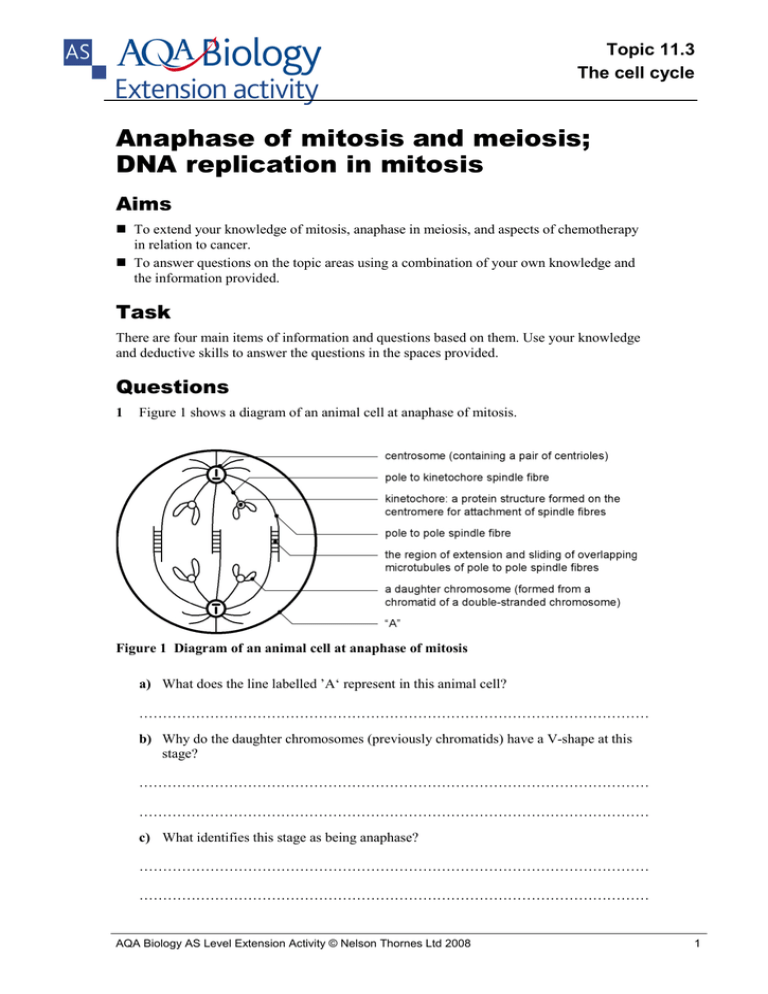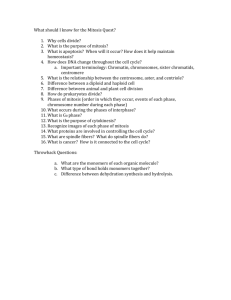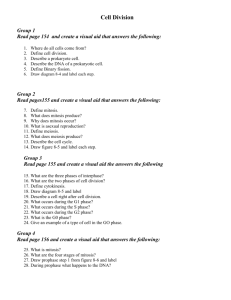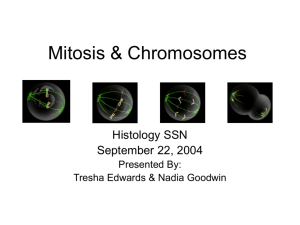Title
advertisement

Topic 11.3 The cell cycle Anaphase of mitosis and meiosis; DNA replication in mitosis Aims To extend your knowledge of mitosis, anaphase in meiosis, and aspects of chemotherapy in relation to cancer. To answer questions on the topic areas using a combination of your own knowledge and the information provided. Task There are four main items of information and questions based on them. Use your knowledge and deductive skills to answer the questions in the spaces provided. Questions 1 Figure 1 shows a diagram of an animal cell at anaphase of mitosis. Figure 1 Diagram of an animal cell at anaphase of mitosis a) What does the line labelled ’A‘ represent in this animal cell? ……………………………………………………………………………………………… b) Why do the daughter chromosomes (previously chromatids) have a V-shape at this stage? ……………………………………………………………………………………………… ……………………………………………………………………………………………… c) What identifies this stage as being anaphase? ……………………………………………………………………………………………… ……………………………………………………………………………………………… AQA Biology AS Level Extension Activity © Nelson Thornes Ltd 2008 1 Topic 11.3 The cell cycle 2 Cancer treatment can involve chemotherapy. Cytarabine (cytosine arabinoside) is used to treat acute myeloid leukaemia (AML). Cytarabine is composed of the nitrogenous base, cytosine, linked to the five-carbon sugar, arabinose. It is quickly converted in the body of patients to the nucleotide, cytosine arabinoside triphosphate. This is structurally similar to the nucleotide, deoxycytidine triphosphate (dCTP), the form in which cytosine becomes incorporated into DNA during DNA replication, before the release of two of its phosphates (as pyrophosphate). When DNA nucleotides are added, the inner phosphate of the incoming nucleotide is attached to the carbon-3 of deoxyribose of the last nucleotide to be added. a) Suggest how cytarabine reduces the activity of a named enzyme that is involved in DNA replication. ……………………………………………………………………………………………… ……………………………………………………………………………………………… ……………………………………………………………………………………………… b) Suggest how cytarabine (as cytosine arabinoside monophosphate) could inhibit further replication of DNA if one molecule of it became part of a growing DNA polynucleotide chain. ……………………………………………………………………………………………… ……………………………………………………………………………………………… ……………………………………………………………………………………………… c) Suggest how cytarabine can be effective in the treatment of cancer, e.g. AML. ……………………………………………………………………………………………… ……………………………………………………………………………………………… ……………………………………………………………………………………………… d) Suggest how cytarabine could cause an AML patient to become more prone to infection than before the treatment. ……………………………………………………………………………………………… ……………………………………………………………………………………………… ……………………………………………………………………………………………… 3 The spindle fibres that form during mitosis are usually composed of about 20 to 40 microtubules, which themselves are polymers of two types of protein molecules, alpha and beta tubulin. These proteins polymerise under the control of the centrosome, a microtubule organising centre (MTOC) of animal cells. The microtubules can grow longer by polymerisation of extra tubulin molecules and can become shorter by their depolymerisation. AQA Biology AS Level Extension Activity © Nelson Thornes Ltd 2008 2 Topic 11.3 The cell cycle a) The spindle fibres of yeast cells are composed of one microtubule. Why can’t they be seen in the light (optical) microscope? ……………………………………………………………………………………………… ……………………………………………………………………………………………… b) In an experiment, cells undergoing mitosis were either treated with detergent or not. Detergent causes ATP to leak out of the cells. Table 1 shows the effects of detergent on the length of the pole to pole spindle fibres and the pole to kinetochore (centromere) spindle fibres. Table 1 Changes of length of spindle fibre type during anaphase with two types of treatment Spindle fibre type Pole to pole Pole to kinetochore (centromere) Changes of length of spindle fibre type during anaphase Detergent-treated cell (ATP leaks out Healthy cell (ATP stays in the cell and of the cell) is used there) No change Longer Shorter Shorter i) Referring to tubulin, microtubules, spindle fibres and the information in Table 1, describe the two processes that bring about movement of daughter chromosomes (sister chromatids) during anaphase. ……………………………………………………………………………………………… ……………………………………………………………………………………………… ……………………………………………………………………………………………… ……………………………………………………………………………………………… ……………………………………………………………………………………………… ii) Taxol (Paclitaxel) is used to treat breast, ovarian and lung cancer. In cells it binds to beta tubulin and prevents disassembly of microtubules. Suggest how it could inhibit tumour growth. ……………………………………………………………………………………………… ……………………………………………………………………………………………… ……………………………………………………………………………………………… 4 Non-disjunction is a failure of segregation of homologous chromosomes or daughter chromosomes/sister chromatids to segregate during anaphase-I or anaphase-II of meiosis, or anaphase of mitosis. Usually the two units involved pass to the same pole. How could a zygote be produced with an XYY karyotype? Refer to the precise anaphase(s) and AQA Biology AS Level Extension Activity © Nelson Thornes Ltd 2008 3 Topic 11.3 The cell cycle chromosome(s) involved in the non-disjunction, and the sex chromosomes of the gametes involved in this fertilisation. ……………………………………………………………………………………………… ……………………………………………………………………………………………… ……………………………………………………………………………………………… AQA Biology AS Level Extension Activity © Nelson Thornes Ltd 2008 4





